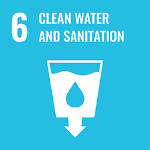About Clean Water and Sanitation
Ensure availability and sustainable management of water and sanitation for all.

We work towards the UN's Sustainable Development Goal 6 - Clean Water and Sanitation , to create a better and fairer world.
The 2030 Agenda for Sustainable Development was adopted in 2015 by all United Nations member states. It provides a blueprint for peace and prosperity for people and the planet.
Find out more about our work across all the UN's Sustainable Development Goals.
Ensure availability and sustainable management of water and sanitation for all.

As the climate becomes more unstable, extreme precipitation events are also occurring more often, and the damage to soil structure caused by extended drought increases the risks of mudslides and flooding when heavy rains fall.
People living in townships in the Cape Flats are experiencing a range of environmental shocks, the impacts of which are made worse by poor infrastructure, poverty, marginalisation and overcrowding.
Working with three communities on the themes of floods, water shortages and fire, researchers worked to better understand residents’ experiences of and responses to the twin threats of water (both dearth and excess) and fire.
Through a series of co-research and co-production activities, researchers mobilised local knowledges to challenge disaster response and risk management practices.
The project was a collaboration between the Sustainable Livelihoods Foundation (a non-profit organisation based in Cape Town, South Africa) and academics working at the Universities of Stirling and Glasgow in the UK and the Universities of Cape Town and Western Cape in South Africa.
Researchers from the University of Stirling developed a study to address the ongoing debate concerning the environmental implications of cryptocurrencies, specifically the impact of Bitcoin trading volume on water and sanitation.
The research employs Ordinary Least Squares (OLS) panel data analysis to examine these relationships using a sample of 32 countries with available Bitcoin trading volume data from 2013 to 2020.
The findings indicate that Bitcoin trading significantly and positively impacts progress towards SDG 6, suggesting potential benefits for water and sanitation initiatives. These results highlight the need to regulate cryptocurrency trading and promote voluntary sustainable practices, particularly given the disparities between developed and emerging markets based on their governance frameworks.
The Institute of Aquaculture (IoA) is an international centre in aquaculture and the largest of its kind in the world. It leads the world in a vision to tackle global problems of food security, hunger and sustainability through aquaculture. This has been recognised through the award of the Queen’s Anniversary Prize. IoA has an international reputation for teaching, world-class research, technological innovation and consultancy in aquaculture.
IoA’s degrees teach students about all subjects relevant to global aquaculture, including the culture of many species, such as crocodiles and turtles. IoA teaches students everything they need to know for a career in aquaculture, marine biology, and related areas such as pharmacy and biotechnology.
People and The Environment is a first-year module that introduces students to the concepts of sustainability, the environment as a holistic working system and the patterns of human resource use. The module develops and explores these concepts and provides student with an understanding of the underpinning, scientific fundamentals. Students explore sustainability through four key themes;
The Estates and Campus Services team work in collaboration with a sustainable water company to clear plant material build up from Airthrey Loch, situated at the heart of our world-leading campus environment. This work improves flow and increases oxygen and water quality with the aim of reducing algal blooms which can occur in the loch. During these works, the University collaborates closely with student societies and community clubs which require access to the loch for their activities and to ensure that these can continue to take place without disruption.
Ultrasonic sound wave units were installed in the University’s Airthrey Loch to provide a permanent solution to the recurring cyanobacteria (blue green algae) issue. These emit ultrasonic waves which create pressure in the top layer of the water which prevent algae from surfacing and absorbing light for photosynthesis. Algae then fall to the loch bed where they are degraded by bacteria. The units offer a non-chemical means for eliminating or mitigating algae without any detrimental effect to fish, plants, zooplankton or insects.
Bringing Scotland’s water sector together to drive us to net zero and beyond. The Scotland Hydro Nation Chair, hosted by the University of Stirling, is leading the collaboration needed to deliver sustainable water management in Scotland.
The project is working across the Scottish water sector and its supply chain to eliminate emissions from infrastructure development and waste water processing, promote our natural environment and manage our processes better, allowing us to recover resource including energy to contribute to a greener, more circular economy.
The initiative is a partnership involving Scottish Water and the Scottish Funding Council.
The Forth Environmental Resilience Array (Forth-ERA) is the first of its kind - a digital observatory of the Firth of Forth's catchment. The project uses near and real-time data flows from sensors, satellites and models to provide a one-stop-shop for environmental data. This enables the Forth catchment’s diverse organisations, from heavy industry to national parks, to take data-led, evidence-based decisions and plan for a sustainable and just transition to a net zero future.
The project helps Scottish Water implement innovative cost-cutting solutions to monitor drinking water quality by providing access to real time data flow and provides early warning information to SEPA, Scotland's principal environmental regulator, on floods and drought in areas at risk of coastal, river and flash flooding.
Forth-ERA is a multi-million-pound investment programme through Scotland’s International Environment Centre, funded as part of the Stirling and Clackmannanshire City Region Deal.